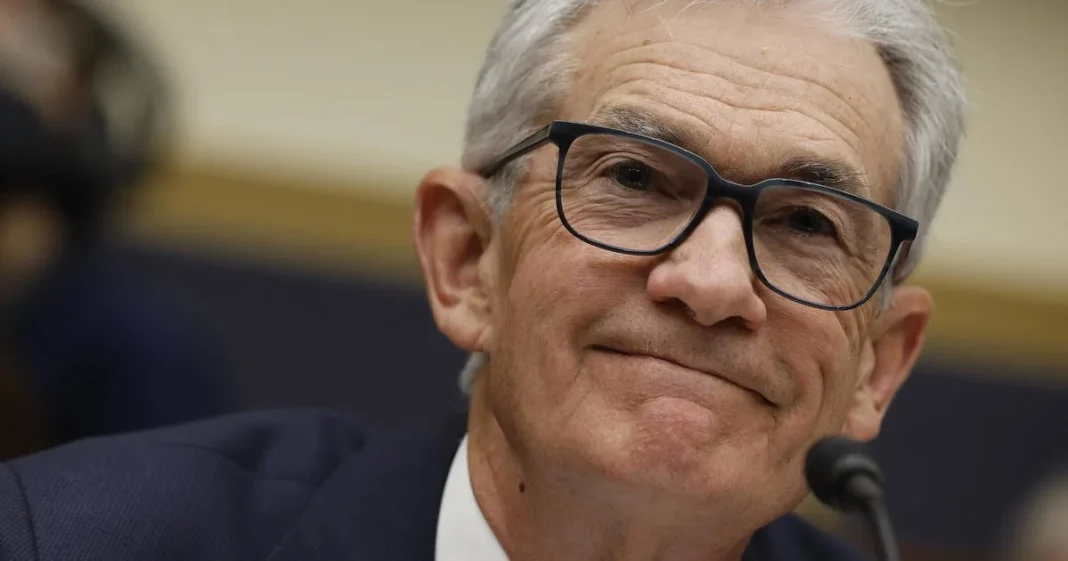The Federal Reserve’s latest rate decision on March 19, 2024, has sent ripples across financial markets, triggering a strong rally in stocks while bond yields continue their downward trend.
Investors and analysts alike are closely dissecting the implications of the central bank’s stance, particularly as it navigates economic uncertainties stemming from inflationary pressures and newly imposed trade tariffs.
Fed Holds Rates Steady, But Cuts Expected in 2025
At its policy meeting on March 19, 2024, the Federal Open Market Committee (FOMC) opted to maintain the federal funds rate at its current range of 4.25%–4.50%. While the decision was widely anticipated, Fed Chair Jerome Powell’s remarks on future rate cuts provided fresh momentum for equity markets.
The central bank’s dot plot now suggests at least two rate reductions in 2025, signaling a cautious yet accommodative stance toward economic growth.
However, Powell acknowledged that new tariffs imposed by the Biden administration could contribute to inflationary pressures, potentially complicating future monetary policy moves.
Stock Market Surge Amid Fed’s Cautious Optimism
U.S. stock markets responded positively to the Fed’s decision. The S&P 500 surged 1.1% on March 19, 2024, following Powell’s statement, while the Dow Jones Industrial Average and Nasdaq Composite also posted gains.
Investors took solace in the Fed’s measured approach, interpreting the comments as a sign that policymakers are willing to support economic stability while monitoring inflation.
Technology stocks led the rally, with major players like Apple, Microsoft, and Nvidia posting significant gains. Financial sector stocks also benefited, as lower long-term interest rate expectations improve the outlook for borrowing and corporate investments.
Bond Yields Retreat as Traders Bet on Rate Cuts
In contrast to equities, U.S. Treasury yields saw a decline, reflecting growing expectations of a dovish Fed in the coming months. The yield on the benchmark 10-year Treasury note dipped below 4.0% for the first time in weeks, while shorter-term yields also fell.
Lower yields typically indicate that investors are pricing in future rate cuts, increasing the appeal of fixed-income assets.
However, analysts caution that a sustained drop in bond yields could be a double-edged sword. While it eases financing conditions for businesses and consumers, it also suggests concerns about slowing economic growth and potential recession risks.
Tariffs, Inflation, and the Fed’s Tightrope Walk
One of the biggest uncertainties facing the Fed is the impact of recently announced tariffs on global trade.
The Biden administration’s new trade policies, announced on March 15, 2024, have raised concerns about inflationary pressures, as increased import costs could feed into consumer prices. Powell acknowledged these risks, stating that the Fed remains vigilant in assessing their long-term effects.
While the central bank remains committed to its 2% inflation target, unexpected price increases could force policymakers to delay rate cuts or even consider additional tightening measures.
This delicate balancing act between supporting economic growth and controlling inflation will be key to shaping market movements in the months ahead.
Global Markets React with Caution
The Fed’s decision has also had a mixed impact on international markets. European indices, including Germany’s DAX and France’s CAC 40, posted slight declines on March 20, 2024, as investors weighed the implications of U.S. monetary policy and ongoing geopolitical uncertainties.
In contrast, Asian markets displayed a varied response, with some indices benefiting from renewed risk appetite while others remained subdued due to concerns over slowing global demand.
Notably, the cryptocurrency market saw a surge in volatility following the Fed’s announcement. XRP, for instance, jumped more than 8% after the SEC dropped its case against the digital asset, reflecting broader investor sentiment shifts across asset classes.
Looking Ahead: Will the Fed Stay the Course?
As markets digest the Fed’s latest decision, the key question remains whether the central bank will maintain its projected rate cut trajectory in 2025. The interplay between inflation trends, labor market dynamics, and geopolitical developments will likely influence future policy moves.
For investors, the Fed’s cautious optimism provides a degree of confidence, but the uncertainty surrounding tariffs and inflation suggests that volatility may persist.
Equities may continue to benefit from expectations of lower borrowing costs, but bond markets will remain sensitive to shifting rate outlooks.
With the next FOMC meeting scheduled for May 1, 2024, all eyes will be on economic indicators that could shape the Fed’s next steps. Until then, the markets will continue their delicate dance, balancing optimism with the realities of an unpredictable economic landscape.
Also Read

